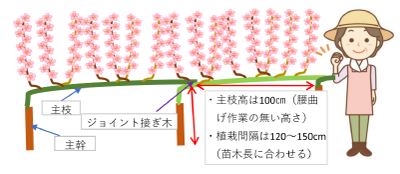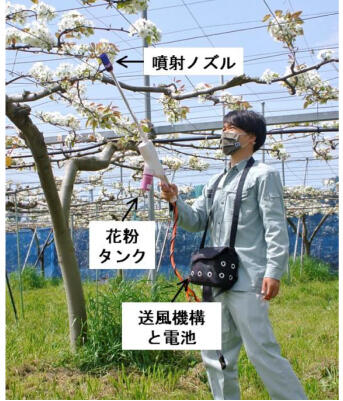(This is an English translation of the original Japanese article.
The publication date refers to that of the Japanese version,
which differs from the upload date of the English version.)
Artificial pollination is essential for fruit trees such as pears and kiwis, which do not bear fruit with their own pollen. However, to obtain the necessary amount of pollen for pollination, many buds must be collected. This task requires a lot of manpower, but due to labor shortages and the aging of producers, it is becoming difficult to carry out on their own, and imported pollen has been increasingly used for pear and kiwi pollination. However, imported one has risks such as price fluctuations, pest contamination and unstable germination rates. Therefore, a research group represented by Tottori University conducted research and development to increase the supply of domestic pollen for three tree species: pears, plums, and kiwis. They have achieved great results such as the devising to create ideal tree shape and the development of bud collection machines. They have also achieved results that would reduce the cost for farmers, such as technology that reduces the amount of pollen used for artificial pollination.
Low tree-height joint training system
Pears are generally cultivated using a trellis system, so collecting buds (flower buds) to obtain pollen is a heavy labor that requires upward work. Therefore, the Saitama Agricultural Technology Research Center and others have examined the time it takes to collect flower buds in a tree shape called "low tree-height joint training" (Figure 1), where the main stem is horizontally trained at a height of about 1m and connected to the next tree one after another. Compared to the usual trellis system, the working time was shortened by about 40-60%, and the amount of arm-raising work was reduced, making the labor load lighter. In Saitama Prefecture, there are already farmers who have adopted "low tree-height joint training" for pollen collection field.

Figure 1: Image diagram of low tree-height joint training
(Provided by Saitama Agricultural Technology Research Center)
Significant labor saving with flower bud picker
The National Agriculture and Food Research Organization (NARO) has developed a "hand-held flower bud harvester" (Photo 1), which significantly reduces the time to harvest flower buds. This harvester works by rotating a rubber brush attached to the end of an extendable rod to knock off the flower buds. In tests conducted by the Gunma Agricultural Technology Center and the Saga Fruit Tree Experiment Station, the time it took to harvest flower buds was reduced by about 70% for plums and about 80% for pears. In February 2022, Sanoh Communications Corp. (Koga City, Ibaraki Prefecture) released a product named "Flower Bud Harvesting Assistant" based on this research.
In response to these research results, plans are coming up in Saitama Prefecture and other areas to use the flower bud harvester to produce pollen in dedicated pollen harvesting fields and sell it./p>

Photo 1: Flower bud harvester (provided by NARO)
Pollen dusting machines that require less pollen
Preparing pollen for artificial pollination by yourself requires labor, and purchasing it requires expenses. For this reason, there is a demand for methods that can reliably set fruit with a small amount of pollen. The Shizuoka Prefectural Research Institute of Agriculture and Forestry and Mitsuwa Co., Ltd. (Tsubame City, Niigata Prefecture) have jointly developed an "electrostatic wind pressure pollinator" (Photo 2), which has electrodes attached to its tip and used to charge the pollen with static electricity, increasing the adhesion rate to the pistil, and then allowing sufficient pollination even with reduced pollen usage. Testing of this pollinator conducted in Shizuoka, Saitama, and Fukuoka prefectures showed the reduction of the amount of pollen used by about 80% for pears, about 50% for plums, and about 60% for kiwis. Currently, they are aiming to put this pollinator into practical use.

Photo 2: Working with the electrostatic wind pressure pollinator
(provided by Shizuoka Prefectural Research Institute of Agriculture and Forestry)
Selecting cultivars with good pollen germination even at low temperatures
In recent years, pears have tended to bloom earlier due to the effects of global warming. When temperatures are low, pollen is less likely to germinate, so if the flowers bloom when the temperature is not high enough, even if pollination occurs, the fruit may not set or may have poor seed development and poor growth.
Associate Professor Yoshihiro Takemura of the Faculty of Agriculture at Tottori University and his colleagues studied the effects of temperature on the germination rates of pollen put on agar culture medium, for 130 varieties of pear and 19 of plum. They found that, while the germination rates of pollen from many pear varieties drop to less than 10% when the temperature falls below 10°C, the pollen from "Nara Yoshino Koboku," "Tosa Pear," and "Imamura Natsu" showed germination rates of over 30% even at the same temperature. Similarly, three plum varieties were selected for their high pollen germination rates at low temperatures.
Mr. Takemura says, "Pollen from pear varieties with excellent low-temperature germination is less affected by climate change and has a higher commercial value than imported pollen with unstable germination rates. If such high-quality pollen becomes widespread, it is not a dream to nurture a business that supplies pollen domestically."
Project name
Research Program on Development of Innovative Technology
Project period
FY2019 to 2021
Title
Development of a Stable Supply System for Domestic Pollen Independent of Imported Pollen
Leading research institutes
Tottori University (representing institution), Saitama Agricultural Technology Research Center, Saga Fruit Tree Experiment Station, Gunma Agricultural Technology Center, Shizuoka Prefectural Research Institute of Agriculture and Forestry, Shizuoka Prefectural Research Institute of Agriculture and Forestry Fruit Tree Research Center, Fukuoka Agriculture and Forestry Research Center, Tokyo Metropolitan Agriculture and Forestry Research Center, Niigata Agricultural Research Institute Horticultural Research Center, Institute of Agricultural Machinery of the National Agriculture and Food Research Organization (NARO), Fukushima Agricultural Technology Center, Nagamine Farm, Sanoh Communications Corp., Mitsuwa Co., Ltd., Food Marketing Research and Information Center
This research project was applied to the Research Program on Development of Innovative Technology project from the research and development platform for fruit tree production system organized in the "Field for Knowledge Integration and Innovation," a mechanism for interdisciplinary fusion and industry-academic collaboration operated by the Ministry of Agriculture, Forestry and Fisheries.
URL for "Field for Knowledge Integration and Innovation"
https://www.knowledge.maff.go.jp/en/fkii.html
